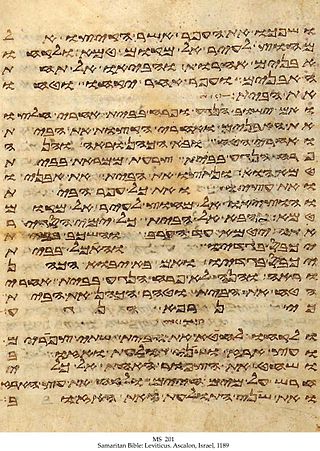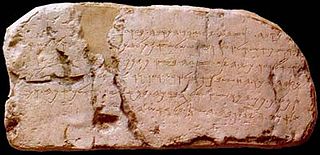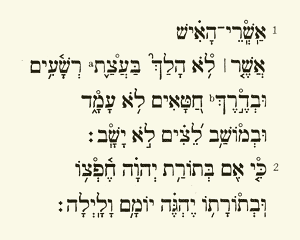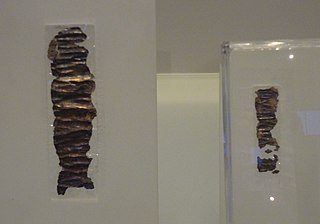Square script may refer to any of several scripts with blocky letters used to write various languages:

An alphabet is a standard set of letters written to represent particular sounds in a spoken language. Specifically, letters correspond to phonemes, the categories of sounds that can distinguish one word from another in a given language. Not all writing systems represent language in this way: a syllabary assigns symbols to spoken syllables, while logographies assign symbols to words, morphemes, or other semantic units.

The ancient Aramaic alphabet was used to write the Aramaic languages spoken by ancient Aramean pre-Christian tribes throughout the Fertile Crescent. It was also adopted by other peoples as their own alphabet when empires and their subjects underwent linguistic Aramaization during a language shift for governing purposes — a precursor to Arabization centuries later — including among the Assyrians and Babylonians who permanently replaced their Akkadian language and its cuneiform script with Aramaic and its script, and among Jews, but not Samaritans, who adopted the Aramaic language as their vernacular and started using the Aramaic alphabet, which they call "Square Script", even for writing Hebrew, displacing the former Paleo-Hebrew alphabet. The modern Hebrew alphabet derives from the Aramaic alphabet, in contrast to the modern Samaritan alphabet, which derives from Paleo-Hebrew.
The Hebrew alphabet, known variously by scholars as the Ktav Ashuri, Jewish script, square script and block script, is traditionally an abjad script used in the writing of the Hebrew language and other Jewish languages, most notably Yiddish, Ladino, Judeo-Arabic, and Judeo-Persian. In modern Hebrew, vowels are increasingly introduced. It is also used informally in Israel to write Levantine Arabic, especially among Druze. It is an offshoot of the Imperial Aramaic alphabet, which flourished during the Achaemenid Empire and which itself derives from the Phoenician alphabet.
The Phoenician alphabet is a consonantal alphabet used across the Mediterranean civilization of Phoenicia for most of the 1st millennium BCE. It was the first mature alphabet, and attested in Canaanite and Aramaic inscriptions found across the Mediterranean region. In the history of writing systems, the Phoenician script also marked the first to have a fixed writing direction—while previous systems were multi-directional, Phoenician was written horizontally, from right to left. It developed directly from the Proto-Sinaitic script used during the Late Bronze Age, which was derived in turn from Egyptian hieroglyphs.

Modern Hebrew, also called Israeli Hebrew or simply Hebrew, is the standard form of the Hebrew language spoken today. Developed as part of Hebrew's revival in the late 19th century and early 20th century, it is the official language of the State of Israel, and the world's only Canaanite language in use. Coinciding with the creation of the state of Israel, where it is the national language, Modern Hebrew is the only successful instance of a complete language revival.

The Samaritan script is used by the Samaritans for religious writings, including the Samaritan Pentateuch, writings in Samaritan Hebrew, and for commentaries and translations in Samaritan Aramaic and occasionally Arabic.
Samaritan Hebrew is a reading tradition used liturgically by the Samaritans for reading the Ancient Hebrew language of the Samaritan Pentateuch, in contrast to Tiberian Hebrew among the Jewish people.

Biblical Hebrew, also called Classical Hebrew, is an archaic form of the Hebrew language, a language in the Canaanite branch of Semitic languages spoken by the Israelites in the area known as the Land of Israel, roughly west of the Jordan River and east of the Mediterranean Sea. The term "Hebrew" (ivrit) was not used for the language in the Hebrew Bible, which was referred to as שְֹפַת כְּנַעַן or יְהוּדִית, but the name was used in Ancient Greek and Mishnaic Hebrew texts.
The Paleo-Hebrew script, also Palaeo-Hebrew, Proto-Hebrew or Old Hebrew, is the writing system found in inscriptions of Canaanite languages from the region of Southern Canaan, also known as biblical Israel and Judah. It is considered to be the script used to record the original texts of the Hebrew Bible due to its similarity to the Samaritan script, as the Talmud stated that the Hebrew ancient script was still used by the Samaritans. The Talmud described it as the "Libona'a script", translated by some as "Lebanon script". Use of the term "Paleo-Hebrew alphabet" is due to a 1954 suggestion by Solomon Birnbaum, who argued that "[t]o apply the term Phoenician [from Northern Canaan, today's Lebanon] to the script of the Hebrews [from Southern Canaan, today's Israel-Palestine] is hardly suitable". The Paleo-Hebrew and Phoenician alphabets are two slight regional variants of the same script.
The Rashi script or Sephardic script is a typeface for the Hebrew alphabet based on 15th-century Sephardic semi-cursive handwriting. It is named for the rabbinic commentator Rashi, whose works are customarily printed in the typeface. It was taken as a model by early Hebrew typographers such as Abraham Garton, the Soncino family and Daniel Bomberg in their editions of commented texts.
He is the fifth letter of the Semitic abjads, including Phoenician hē 𐤄, Hebrew hē ה, Aramaic hē 𐡄, Syriac hē ܗ, and Arabic hāʾ ه. Its sound value is the voiceless glottal fricative.

In a right-to-left, top-to-bottom script, writing starts from the right of the page and continues to the left, proceeding from top to bottom for new lines. Arabic, Hebrew, and Persian are the most widespread RTL writing systems in modern times.
Cursive Hebrew is a collective designation for several styles of handwriting the Hebrew alphabet. Modern Hebrew, especially in informal use in Israel, is handwritten with the Ashkenazi cursive script that had developed in Central Europe by the 13th century. This is also a mainstay of handwritten Yiddish. It was preceded by a Sephardi cursive script, known as Solitreo, that is still used for Ladino.

The Arabic script is the writing system used for Arabic and several other languages of Asia and Africa. It is the second-most widely used alphabetic writing system in the world, the second-most widely used writing system in the world by number of countries using it, and the third-most by number of users.

Ktav Ashuri also (Ktav) Ashurit, is the traditional Hebrew language name of the Hebrew alphabet, used to write both Hebrew and Jewish Babylonian Aramaic. It is often referred to as (the) Square script. The names "Ashuri" (Assyrian) or "square script" are used to distinguish it from the Paleo-Hebrew script.

The Hebrew alphabet is a script that the Aramaic alphabet was derived from during the Persian, Hellenistic and Roman periods. It replaced the Paleo-Hebrew alphabet which was used in the earliest epigraphic records of the Hebrew language.
Biblical Hebrew orthography refers to the various systems which have been used to write the Biblical Hebrew language. Biblical Hebrew has been written in a number of different writing systems over time, and in those systems its spelling and punctuation have also undergone changes.

Paleo-Hebrew Leviticus Scroll, known also as 11QpaleoLev, is an ancient text preserved in one of the Qumran group of caves, and which provides a rare glimpse of the script used formerly by the Israelites in writing Torah scrolls during pre-exilic history. The fragmentary remains of the Torah scroll is written in the Paleo-Hebrew script and was found stashed away in cave no. 11 at Qumran, showing a portion of Leviticus. The scroll is thought to have been penned by the scribe between the late 2nd century BCE to early 1st century BCE, while others place its writing in the 1st century CE.

The Ketef Hinnom scrolls, also described as Ketef Hinnom amulets, are the oldest surviving texts currently known from the Hebrew Bible, dated to c. 600 BCE. The text, written in the Paleo-Hebrew script, is from the Book of Numbers in the Hebrew Bible, and has been described as "one of the most significant discoveries ever made" for biblical studies.